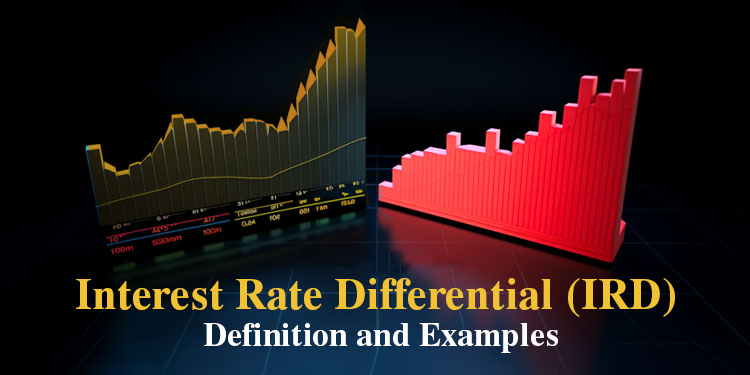The very first definition for Interest rate differential (IRD) is that the IRD is the difference between the rates of interest of two similar investments or two interest-bearing assets. This dice measures the differences between the two investments, and it is specially applied in foreign exchange markets, stock trading, bank mortgages, etc.
Any investor can use and take advantage of IRD by selecting the assets they want to invest in and getting some basic knowledge in that field. Financial experts follow the IRD with attention and care because they want to make as much profit as they can and are eager to trade as profitably as possible. However, not just investors but also any individual can make better decisions in the housing market when borrowing by examining the differences in interest rates of mortgages.
Table of Contents
What is an Interest Rate Differential (IRD)?
An interest rate differential (IRD) is a dice to measure and weigh the possible interest rate contrasts among two interest-bearing assets that have some similarities, or the measure is in search of similarities. However, most of the time, it focuses on defining the difference between the two interest rates.
Traders who are trading in the field of foreign exchange markets apply IRDs to estimate exchange rates in advance. A trader can estimate the future exchange rate of two different currencies and launch a discount on the current exchange rate of the market with close consideration of the future contracts.
read more: Forex Strategies
How to find out and calculate the Interest Rate Differential (IRD)
As defined before, IRDs weigh and measure the difference in interest rates between two currencies and securities. That is, if a bond can earn 3% and the other one can gain 5%, the IRD will easily be calculated as 2 percent which is equal to 200 basis points (bps). It is wise to use IRD calculations in forex trading, fixed income trading, and lending calculations, as professionals in Aron Groups advise.
The use of IRD in the housing market is about mortgage rates and is to know the difference between the bank’s defined rate on the date for prepayment.
Also, IRD and applying its strategy is a trading method that is based on borrowing at a low-interest rate, making the investment gain, and providing a higher profit and return is the other important factor that is being carried by the method known as IRD trading. The IRD concept simply means borrowing with a low-interest rate of the currency and exchanging the borrowed money for some other currency with a greater output.
An explanation for Interest Rate Differential (IRD)
Especially after all the economic change that happened in the first decade of the twenty-first century, interest rate differential has earned eminence as a financial issue, and people have knowledge of the positive and negative sides of the IRD affecting their profits.
Now, it is time to define the interest rate differences. First of all, this rate difference can appear as the result of the difference between the risk factors within the investments, so, as a result, the investment risk affects the return amount. After that, the assets, property, and nature are the other issues. The type of security, like stock, bond, etc., affects the interest rate difference. Next, all inefficiencies and imperfections in the market might affect the interest rate. The power of this affection, most of the time, is the result of the economic situation of the country. Finally, issues like interest rates and prices are influenced by supply and demand, which can be a reason for the differences between two similar investments or interest rates.

What is the role of IRD in the trading market?
The strong connection between interest rate differential and exchange rate is inevitable. The present interaction of the two concepts has a direct effect on the market of currency trading. Also, this phenomenon has found its great and effective role in mortgage interest rates, and it has a stronger and bolder role throughout the mortgage. Lastly, the role of IRD can be seen in stock trading when two similar assets offer different interest rates. IRD is a useful tool in doing trade, and it is a strategy for investors to borrow when the rate of interest is low and then to invest when the return amount is higher.
An example of bond trade in IRD
The amount of profit that an investor expects to gain by doing a trade is IRD. For example, an investor or a trader borrows an amount of $5,000 and exchanges the mentioned capital into British pounds. Now, if the earned bond is about 8% and the equivalent amount of the U.S. bond is about 4%, the IRD will equal the amount of 4%, which has been calculated by the equation 8% – 4%. If the present exchange rate of dollars and pounds keeps its stability, this profit will be ensured.
Uncertainty and unpredicted fluctuations of the currency are among the first risks with this IRD strategy. In our mentioned example, if the British pound’s value falls against the U.S. dollar, the trader will face investment loss.
Moreover, traders can apply leverage like a 10-to-1 shift so that they can improve their potential gain and profit. Whenever the trader leverages the borrowing by a factor like a 10-to-1, they are making a 40% profit.
An example of IRD in a mortgage example
There is IRD when people borrow money to buy a house. To offer an example, a buyer draws a mortgage at a 5.50% rate for 30 years to buy property or land. Now, if the buyer is in a condition that still has five years to fulfill their mortgage debt and 25 years have passed from their mortgage, the lender can use the current market interest rate, which is possible for a five-year mortgage, and determine an IRD. The IRD is 1.65% or 0.1375% monthly if the interest rate of the current market for a five-year mortgage is 3.85%.
Some IRD calculations to learn more about this phenomenon
It is better to clarify the formula for interest rate differential:
IRD = Interest rate of 1st investment – Interest rate of 2nd investment
Many online tools act like interest rate differential calculators, which guide investors, traders, and borrowers to calculate the difference with no difficulty.
Some clear examples are:
Bond
The first example that comes to mind is to compare EUR/ USD. There is a trader with $500 and exchanges it into a Euro and buys the stock of a European company, like X. It is expected that the interest rate of the investment will be 9%. However, if the same person had invested in a U.S. company using his dollars, the interest rate on that investment could have been 8%.
What about the IRD in this example?
(Interest rate)1 – (Interest rate)2 = IRD
That is, 9% – 8% = 1%
Mortgage
Let’s have a look at another example within the housing market. There is a buyer with $400,000 who wants to buy a house. The borrowing interest rate has been 7.5%, with a 20-year loan term. After 10 years, this person figures the interest rate of the bank for a ten-year mortgage, which is 6%.
Now, what is the IRD in this case?
IRD = 7.5% – 6% = 1.5%
The difference between Interest Rate Differential (IRD) and Net Interest Rate Differential (NIRD)
The very first difference between IRD and NIRD that comes to mind is that the first one is widely used in forex market, stock trading, housing markets, etc., while the other one, NIRD, is to determine the gap between the interest rate in two countries. It is possible to use the NIRD in the forex markets in relation to currencies as well.
Finance experts and traders of any field investigate NIRD because they want to understand the interest rates’ variance, and they want to get knowledge about the effects that a trader may get from their investment in return. But both of the phenomena might compare in terms of interest rates’ variance, which can be investments, assets, mortgage interest rates, etc.
What is the difference between Interest Rate Differential (IRD) and Net Interest Rate Differential (NIRD)?
The net interest rate differential (NIRD), which is specific to the forex market, is considered a subcategory of IRD. The NIRD is the difference between the interest rates of two distinct economic regions in international currency markets.
For example, imagine a trader who is interested in the NZD/USD pair; this person probably borrows the U.S. currency while they own the New Zealand currency. New Zealand dollars probably are in a New Zealand bank and are drawing a loan equivalent to the same amount from a U.S. bank at the same time. The difference between the earned and paid interests while holding the currency pair is called NIRD.
What is the benefit of calculating the Interest Rate Differential?
A trader can demonstrate the interest rate differences between two financial securities using IRD calculations.
Is the Interest Rate Differential possible to use in real estate?
When real estate customers and all other traders want to count the mortgage prepayment dates, for example, use IRD to demonstrate the rate difference between the banks’ interest rates.
FAQs
The investor borrows money at a low-interest rate of the currency and then exchanges it for a higher-value currency in carry trade investing. The difference between the two interest rates is the IRD.
Brief answers to some primary questions in this field

































